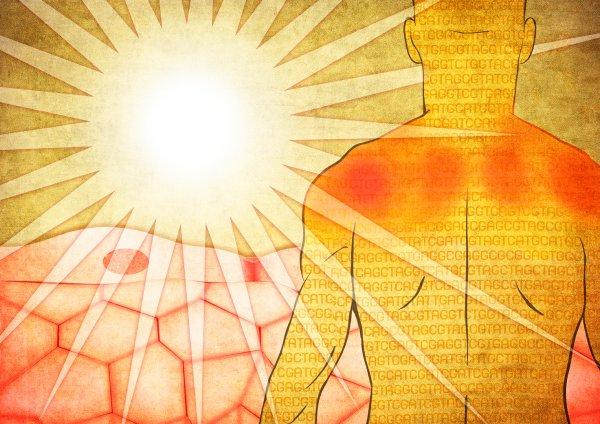![Researchers found that the UV radiation resistance-associated gene (UVRAG) is a tumor suppressor for skin cancer, which is the most common form of cancer in the United States. [Ernesto del Aguila III, NHGRI]](https://genengnews.com/wp-content/uploads/2018/08/97514_large1761621991-1.jpg)
Researchers found that the UV radiation resistance-associated gene (UVRAG) is a tumor suppressor for skin cancer, which is the most common form of cancer in the United States. [Ernesto del Aguila III, NHGRI]
Just in time for Melanoma/Skin Cancer Detection and Prevention Month, a new study led by researchers at the University of Southern California (USC) has identified a “sunscreen” gene that may help stave off skin cancer. Melanoma—the deadliest form of skin cancer—has seen rates double over the last three decades, according to the CDC, causing scientists to be even more vigilant in their search to understand the underlying molecular mechanisms of ultraviolet (UV)-induced skin damage better. In this new study, investigators found that the UV radiation resistance-associated gene (UVRAG) was a tumor suppressor for skin cancer.
“If we understand how this UV-resistant gene functions and the processes by which cells repair themselves after ultraviolet damage, then we could find targets for drugs to revert a misguided mechanism back to normal conditions,” explained senior study author Chengyu Liang, Ph.D., associate professor of molecular microbiology and immunology in the Keck School of Medicine at USC.
The findings from this study were published recently in Molecular Cell in an article entitled “Autophagic UVRAG Promotes UV-Induced Photolesion Repair by Activation of the CRL4DDB2 E3 Ligase.”
“People who have the mutated UV-resistant gene or low levels of the UV-resistant gene may be at higher risk of melanoma or other skin cancers, especially if they go sunbathing or tanning frequently,” Dr. Liang noted. “Our study suggests that the UV-resistant gene may serve as a biomarker for skin cancer prevention.”
The USC team utilized data from 340 melanoma patients who had their genetic information deposited into The Cancer Genome Atlas. The study also included two experimental groups with either reduced levels of UVRAG or a mutant copy of that gene in melanoma cells or 50 fly eyes, using normal UVRAG copies as controls.
The researchers subsequently gave a UV pulse to cells carrying the normal UVRAG and cells carrying defective copies of it. After 24 hours, cells carrying healthy versions of the gene had repaired more than 50% of the UV-induced damage. In contrast, the defective samples repaired less than 20% of the damaged cells.
“That means when people sunbathe or go tanning, those who have the normal UV-resistant gene can repair most UV-induced DNA burns in a timely manner, whereas those with the defective UV-resistant gene will have more damage left unrepaired,” Dr. Liang remarked. “After daily accumulation, if they sunbathe or go tanning often, these people will have increased risk of developing skin cancers such as melanoma.”
![The researchers found that UVRAG is involved in the multistep DNA cell-repair process. [Molecular Cell, Volume 62, Issue 4, May 19, 2016]](https://genengnews.com/wp-content/uploads/2018/08/fx12351391752.jpg)
The researchers found that UVRAG is involved in the multistep DNA cell-repair process. [Molecular Cell, Volume 62, Issue 4, May 19, 2016]
Importantly, the researchers were able to show a correlation with increased cancer risk. However, their study did not definitively connect diminished levels or mutant copies of UVRAG with skin cancer development.
“The UV-resistant gene is a tumor suppressor involved in the UV-repair process of a cell's DNA and is essential for preventing UV-induced genomic instability,” explained lead study author Yongfei Yang, Ph.D., research associate in the Keck School Medicine at USC. “When the UV-resistant gene is lost, the cell cannot efficiently repair UV- and chemical-induced damage.”
UVRAG is involved in the multistep DNA cell repair process, researchers found. First a known protein scans for damaged DNA. Once it finds lesions, it tags the UV-resistant gene into action. The UV-resistant gene is like a humanitarian convoy dropping off reinforcements or aid to help damaged areas repair at precisely the right time.
Unfortunately, the research team did not have data from people without skin cancer, so they were unable to compare their observations of melanoma patients with those of skin cancer-free people.
“We found the expression level of the UV-resistant gene is related to melanoma patients' survival and metastasis stages,” Dr. Yang said. “Lower levels of the UV-resistant gene mean a lower survival rate and advanced metastases stages.”
“To our knowledge, the UV-resistant gene does not have any enzymic activity; it's a supporter or coordinator,” Dr. Liang added. “Although it may not be the direct doer, without it, the whole structure collapses.”
The investigators are looking toward future studies that will use mouse models to understand better how UVRAG functions.
“The UV-resistant gene may serve as a good target for drug development,” concluded Dr. Yang. “Perhaps one day a drug could stimulate the repairing functionality of the UV-resistant gene to ensure swift and effective repair of UV-damaged skin cells. That would be a good treatment for people who are at high risk of developing skin cancer.”


